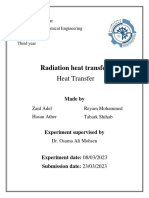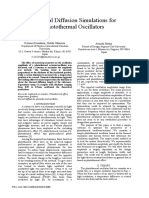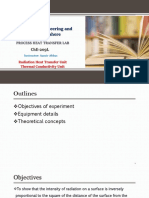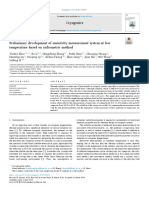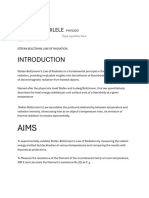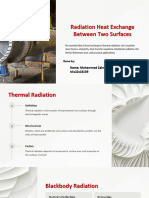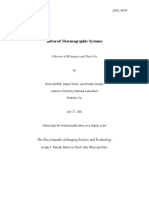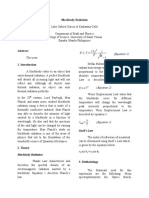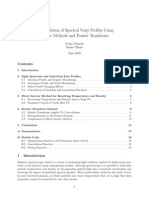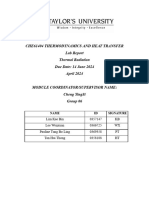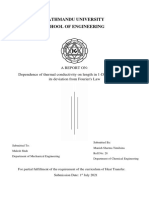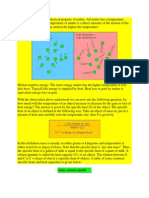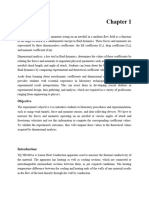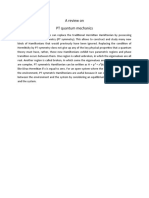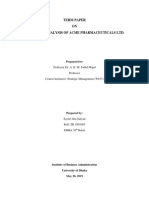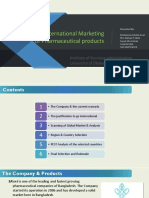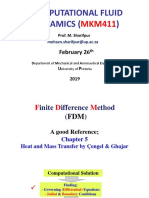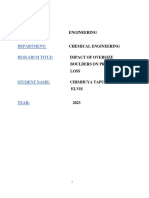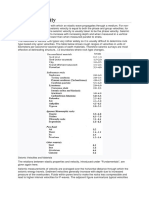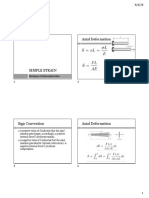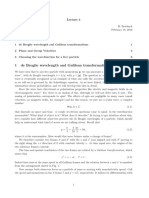CAPE2030 Experiment 4: Thermal Conductivity and Radiation Your Name (ID No. XXXXXXXXX)
CAPE2030 Experiment 4: Thermal Conductivity and Radiation Your Name (ID No. XXXXXXXXX)
Uploaded by
Sayed Abu SufyanCopyright:
Available Formats
CAPE2030 Experiment 4: Thermal Conductivity and Radiation Your Name (ID No. XXXXXXXXX)
CAPE2030 Experiment 4: Thermal Conductivity and Radiation Your Name (ID No. XXXXXXXXX)
Uploaded by
Sayed Abu SufyanOriginal Title
Copyright
Available Formats
Share this document
Did you find this document useful?
Is this content inappropriate?
Copyright:
Available Formats
CAPE2030 Experiment 4: Thermal Conductivity and Radiation Your Name (ID No. XXXXXXXXX)
CAPE2030 Experiment 4: Thermal Conductivity and Radiation Your Name (ID No. XXXXXXXXX)
Uploaded by
Sayed Abu SufyanCopyright:
Available Formats
CAPE2030 Experiment 4: Thermal Conductivity and Radiation
Your name (ID No. XXXXXXXXX)
School of Chemical and Process Engineering, University of Leeds, Leeds LS2 9JT , UK
_________________________________________________________________________________ ______________________
5 Abstract
This report details the experiments conducted in the laboratory to demonstrate the concepts of radiation and thermal conductivity
of metal samples. The first three experiments demonstrate the concepts of radiation and the last experiment illustrates the thermal
conductivity of two metal samples. In experiment 1, the effect of intensity of radiation with respect to view factor was
investigated and it was found that the radiation intensity from a source is directly proportional to the emitted radiation from the
10 source. Experiment 2 was conducted to determine the association between view factor and radiation intensity and it is obtaine d
that the radiation intensity of a surface is inversely proportional to the square value of the distance of the source. Again,
experiment 3 investigates the variation of radiation intensity with respect to the temperature of the source and the Stefan-
Boltzmann law was validated from the results of the experiment. Finally, in experiment 4, the thermal conductivity of two metal
samples was calculated using the interface temperature and it is found that metal A has a higher thermal conductivity than that of
15 metal sample B. The finding of this experiment is indeed very helpful in determining which metal can be used for engineering
applications where a higher thermal conductivity is required, for instance, metal A can be used in heat exchanger application.
Introduction In the case of conduction heat transfer, heat flow can be
calculated using Fourier’s law from which thermal
60 conductivity of the material can be calculated.
Thermal radiation, also referred to as heat, is occurred
20 because of the emission of electromagnetic waves from
materials that are at a temperature higher than absolute zero
temperature (Siegel et al., 2001). In this case, thermal energy In this equation, is the thermal conductivity of the
is converted into electromagnetic energy which is transmitted 65 material sample, Q is the amount of heat flow through the
through the direct contact of molecules without any movement material, is the surface area of heat flow, is the
25 of the material. Usually, all materials radiate energy (which difference in distance between the hot and cold surface, and
depends on the temperature of the materials) and the radiated is the difference in temperature between the hot and cold
energy is transferred by the photons of light (mainly the
surface.
infrared and visible parts of the electromagnetic spectrum).
70
Here, the spectrum typically follows the radiation curve of a
The main purpose of this laboratory experiment was to
30 black body and according to Stefan-Boltzmann law, the
investigate the factors associated with radiation heat transfer.
energy emitted per unit area of a black-body can be obtained
A series of experiments were conducted in order to evaluate
using the following formula:
the association of different properties that influence thermal
75 radiation such as the relationship between view factor and
radiation intensity (experiment 1), the relationship between
35
radiation intensity and distance between the radiation surface
In the above equation, is the amount of emitted energy and source (experient 2), and effect of temperature on the
from the black body per unit area ( ), is Stefan- intensity of the radiation (experiment 3). In the 4, the thermal
Boltzmann constant ( ), and is the 80 conductivity of the two metal samples will be determined.
absolute temperature of the lack body and the surroundings
40 respectively (K) (Harrington, 2014).
Methodology
Thermal conductivity is an important property of a material
and has been used in nearly every engineering applications.
Experiments 1, 2, and 3 were conducted using the same
Thermal conductivity is defined as the ability of a material to
85 experimental procedure and the same apparatus experimental
45 transfer heat energy, and this heat energy can be transferred
where the black body was used as the radiation or heat source
by different means such as electromagnetic waves, electrons,
which was heated using a power source. In order to measure
and photons of light. However, thermal conductivity is not a
the intensity of radiation, a radiometer was used.
fixed property as it varies with temperature for isotropic
materials. For any material, thermal conductivity is reported
90 In experiment 1, the experimental readings were collected by
50 as a function of temperature (Tritt, 2006). The procedure for
changing the distance (ranging from 0.9 m to 0.2 m) between
measuring the thermal conductivity of a material is not an
the black body and the radiometer. Before starting the
exact or direct process and usually involves the theory and
experiment, a few minutes were allowed to stabilise the
concept of heat transfer from high temperature to low
system between each repeated test. When the system became
temperature.
95 stabilised, the temperature of the surface, as well as the
55
surrounding temperature, were recorded. The intensity of the
radiation was also calculated by demonstrating the association Table 1: Experimental results for experiment 1
between the radiation from the source with respect to the view 65
factor and the measured radiation intensity from the Amb T10 Distance F Heat Fqb R Rc
radiometer. The view factor was calculated from the distance t (K) (K) From flux
5 (x) from the surface whereas the received amount of energy emitter
by the detector (R) was obtained from Stefan-Boltzmann law (m)
as follows: 297.1 564.4 0.9 0 5319.81 12.55 13 10.2
297.2 563.1 0.7 0 5265.72 16.2 19.8 15.5
297.2 562.2 0.5 0 5229.31 21.43 35.4 27.8
10
297.2 561.9 0.3 0.01 5660.2 41.62 90.1 70.7
297 562.5 0.2 0.01 5243.21 45.2 194.3 152.5
As mentioned earlier, the above procedure was adopted for
both experiments 2 and 3. In experiment 2, the association
between view factor and radiation intensity was determined in
order to obtain that the radiation intensity of a surface is
15 inversely proportional to the square value of the distance of
the source (which is called the inverse square law). 70
In experiment 3, the variation of radiation intensity with
respect to the temperature of the source was determined.
20 According to the theory, the intensity of radiation is directly
proportional to the fourth power of the temperature of the
75
source of radiation. Though the procedure in this experiment
was same as other twos except in this case the distance
between the black body and the radiometer was adjusted to
25 0.3 m and the applied voltage on the power source was
adjusted within a range of 240-50 V. Again, the intensity of
radiation was recorded as well as temperatures (T9 & T10). 80
Finally, in experiment 4, the thermal conductivity of the two Figure 1: Heat Flux from the surface of blackbody vs. heat flux
30 metal samples was calculated. According to the experimental corrected
procedure, the heated and cooled sections’ surface was
marked using thermal conducting paste and then they were
clamped together by putting an aluminium part in between. It 85 Results and Calculation for Experiment 2:
was ensured that the cooling water was flowing throughout
35 the experiment and the voltage was set to 150 V. After Table 2: Experimental results for experiment 2
stabilising the temperature, the values of temperature (T1, T2,
T3, T6, T7, and T8) were measured and recorded as well as T10 X R Rc Log(x) Log(Rc)
the values of current and voltages. The above procedure was (0C) (mm) (W/m2) (W/m2)
repeated for stainless steel metal sample and the whole 282 900 13 10.2 2.95 1
40 procedures were repeated three times and all respective 280.7 700 19.8 15.6 2.85 1.19
readings were recorded for further calculation. 279.4 500 35.4 27.8 2.7 1.55
280.8 300 90.1 70.8 2.48 1.95
279.9 200 194.3 152.7 2.3 2.28
Results
90
Results and Calculation for Experiment 1:
45
According to Stefan-Boltzmann law:
95
50 View factor (F) can be obtained using the following formula:
In this equation, x is the distance between black body surface 100
55 and radiator and a is the radius of the black body emitter
which is 50 mm. In this case, the corrected radiation intensity
(Rc) is calculated using a factor of c which is 0.786.
Again, heat flux from the surface of the black body is
60 multiplied with view factor F as follows: 105
Figure 2: Plot between log 10 (RC) against log 10 (x)
Results and Calculation for Experiment 3:
40
Table 3: Experimental results for experiment 3
T10 ø Ø4 R Rc qb (W/m2)
(0C) (W/m2) (W/m2)
62.4 2.386 64.72 17 13.362 289 45
123.1 5.521 928.6 29.4 23.1084 965.8
280.8 11.65 18430 90.1 70.8186 4896.4
5
50
10
Figure 4: Temperature variation at different distances from the
thermocouple for metal A and B
55
15
Table 6: Thermal conductivity calculation for metal A and B
Parameter Metal A Metal B
Voltage (V) 150 150
20 Figure 3: Heat flux against Ø4 Current (A) 163 163
Heat Flow (W) 24450 24450
Results and Calculation for Experiment 4: (m2) 0.000491 0.000491
(k) 59.2 98.9
Thermal conductivity of metal sample B: (K) 34.3 27
25 Heat flow:
(m) 0.03 0.03
( ) 60.02 20.78
Surface area of Heat flow:
Thermal conductivity can be calculated following equation. Discussion
30 60 In experiment 1, the effect of intensity of radiation with
Therefore: respect to view factor was investigated and the results from the
experiment have been illustrated in figure 1 which suggests a
linear relationship between Rc and Fqb. From the obtained data it
is clear that with the increase in distance from the emitter, both
Table 4: Experimental results for experiment 4- Metal A 65 the values of Rc and Fqb have decreased. For instance, at a
35 distance of 900 mm, the value of Rc was 10.2 and Fqb was 12.55,
Temperatures 1 2 3 Average Average but when the distance was decreased to 300 mm then Rc became
(0C) (K) 10.2 and Fqb became 12.55. Similarly, the calculated heat flux
T1 108.6 109.6 110.3 109.5 382.5 was found to be decreased with the increase in distance x.
T2 102.7 103.6 104.3 103.5 376.5 70 According to theory, the plot between Rc and Fqb should be
T3 98.1 99 99.7 98.9 371.9 straightly linear whereas in this case some of the data points have
T6 26.7 27 27.2 27.0 300.0 deviated which could have happened due to the error in
T7 23.1 23.3 23.4 23.3 296.3
determining the distance x. To improve this further, a ruler scale
T8 19 19 19.2 19.1 292.1
can be used instead of measuring the distance by hand.
Table 5: Experimental results for experiment 4- Metal B 75 From the results of experiment 2 it is obtained that with the
increase of the distance between the radiometer and the
Temperatures 1 2 3 Average Average blackbody surface, the intensity of radiation decreases and
(0C) (K) this is supported by the inverse square law (Khachan, 2018).
T1 78.7 70.3 69.2 72.7 345.7 Figure 2 demonstrates the same condition, however, the line
T2 70.7 63 62 65.2 338.2 80 was not straight as it is supposed to be according to theory.
T3 64.3 57.2 56.2 59.2 332.2 This could be because of experimental error such as
T7 36.8 33.2 32.9 34.3 307.3 inconsistent wait-time to stabilise the system etc.
T8 30.9 27.9 27.7 28.8 301.8
T9 23.8 21.6 21.6 22.3 295.3
Figure 3 demonstrates that the intensity of radiation is directly
proportional to the fourth power of the temperature of the
source of radiation as obtained from a linear relationship. This
is evident from the fact that the emitter which was supplied
5 with reduced temperature would certainly emit reduced
thermal radiation. Though the straight-line equation is aligned
with the theory, the line is not straight enough which could be
due to experimental error. For instance, the fan that has used
during the experiment could have prevented the black body
10 from overheating. Again, at the first, the convection heat
transfer was much slower and from this, it could be suggested
that after turning off the fan the temperature of the black body
surface could have changed because of reheating.
15 Finally, in experiment 4, the thermal conductivity of metal
samples was calculated and it was found that aluminium has
higher thermal conductivity than that of stainless steel.
Furthermore, figure 4 demonstrates that the heat transfer rate
is much faster in the case of metal A (aluminium) than that of
20 metal B (stainless steel). From the calculations, it is obtained
that the thermal conductivity of metal A and metal B is 60.02
and 20.78 kW/mK respectively. The finding of this
experiment is indeed very helpful in determining which metal
can be used for engineering applications where a higher
25 thermal conductivity is required, for instance, metal A can be
used in heat exchanger application.
Conclusions
Overall the objectives of all the four experiments that were
30 conducted in the laboratory were successful in demonstrating
the underlying concepts of radiation and thermal conductivity.
From the finding of the first experiment, it was found that the
radiation intensity from a source is directly proportional to the
emitted radiation from the source. From experiment 2 it was
35 found that the radiation intensity of a surface is inversely
proportional to the square value of the distance of the source.
Again, the Stefan-Boltzmann law was validated from
experiment 3 where it was obtained that the intensity of
radiation is directly proportional to the fourth power of the
40 temperature of the source of radiation. Finally, the thermal
conductivity of metal samples was calculated and found that
aluminium has higher thermal conductivity than that of
stainless steel. The conclusion, therefore, to be made is that
the report will be helpful to conduct these experiments in the
45 future and would be helpful in industrial and engineering
applications.
References
50 Harrington, V., 2014. Thermal Engineering. World Technologies.
Khachan, J., 2018. Thermal Properties Of Matter. Morgan &
Claypool Publishers.
Siegel, R., Howell, J. and Mengüç, M., 2001. Thermal Radiation
Heat Transfer. 4th ed. CRC Press.
55 Tritt, T., 2006. Thermal Conductivity: Theory, Properties, And
Applications. Springer Science & Business Media.
You might also like
- Motion On An Inclined Plane Sample Lab ReportDocument3 pagesMotion On An Inclined Plane Sample Lab Reportskysky96100% (5)
- ENGR135 - LAB05 Stephan Boltzmann's LawDocument12 pagesENGR135 - LAB05 Stephan Boltzmann's Lawgigabyte3235840No ratings yet
- Customer List of Dow 2015 - Ajay IntDocument7 pagesCustomer List of Dow 2015 - Ajay IntSayed Abu SufyanNo ratings yet
- Thermal RadiationDocument5 pagesThermal RadiationBor OtNo ratings yet
- Act 5 RadiationExperiments Grp1Document10 pagesAct 5 RadiationExperiments Grp1Junn Edgar LibotNo ratings yet
- 1 Accepted ManuscriptDocument30 pages1 Accepted ManuscriptDimas Arifin PutraNo ratings yet
- Stefan-Boltzmann Law: Lab ReportDocument12 pagesStefan-Boltzmann Law: Lab ReportZeenat RanaNo ratings yet
- Inverse Square Law of HeatDocument10 pagesInverse Square Law of HeatBoomday100% (1)
- Physics Experiment Report The Stefan-Boltzmann Radiation Law (By A Kriel)Document8 pagesPhysics Experiment Report The Stefan-Boltzmann Radiation Law (By A Kriel)Alyssa Kriel86% (7)
- Inverse Square Law of HeatDocument9 pagesInverse Square Law of HeatAl Drexie BasadreNo ratings yet
- CHE34 LabReport Group5 Activity1Document4 pagesCHE34 LabReport Group5 Activity1Ian LuyaoNo ratings yet
- هيت كورس ثانيDocument7 pagesهيت كورس ثانيahmad243809No ratings yet
- Heat FluxDocument5 pagesHeat FluxshaunakchatNo ratings yet
- Thermal Radiation: Abolencia, Edin Hayel T., Sanchez, Krizia, Soriano, AllanDocument3 pagesThermal Radiation: Abolencia, Edin Hayel T., Sanchez, Krizia, Soriano, AllanEdin AbolenciaNo ratings yet
- Experiment 2 Thermal RadiationDocument8 pagesExperiment 2 Thermal RadiationRicky JayNo ratings yet
- Infrared Thermographic Systems: A Review of IR Imagers and Their UseDocument54 pagesInfrared Thermographic Systems: A Review of IR Imagers and Their UsedansileshiNo ratings yet
- 光热振荡器的热扩散模拟Document6 pages光热振荡器的热扩散模拟jianan yaoNo ratings yet
- Group 2 - BSCE1 3 - Formal Lab Report#6 - CET 0122.1 11 2Document5 pagesGroup 2 - BSCE1 3 - Formal Lab Report#6 - CET 0122.1 11 2John Eazer FranciscoNo ratings yet
- Thermography Fundamentals and First Principals of Natural Sciences and Engineering SciencesDocument12 pagesThermography Fundamentals and First Principals of Natural Sciences and Engineering SciencesNabil AbdullahNo ratings yet
- Gathers 1986Document57 pagesGathers 1986Михаил ПарамоновNo ratings yet
- Infrared and Thermal Testing: Part-ADocument28 pagesInfrared and Thermal Testing: Part-Adeepak kantipudiNo ratings yet
- Thermodynamics Heat Conduction-1Document4 pagesThermodynamics Heat Conduction-1Aditya AnuragNo ratings yet
- Thermal Radiation ExperimentDocument4 pagesThermal Radiation ExperimentloginfornagpalNo ratings yet
- Online Lab 4Document17 pagesOnline Lab 4nnbNo ratings yet
- 1 s2.0 S0011227523000450 MainDocument6 pages1 s2.0 S0011227523000450 MainRev TamasNo ratings yet
- Radiation 5 PDF FreeDocument18 pagesRadiation 5 PDF FreeRose RayNo ratings yet
- Thermal Radiation Heat Transfer Between Surfaces Luka KlobucarDocument12 pagesThermal Radiation Heat Transfer Between Surfaces Luka Klobucarmichael100% (1)
- Infrared Thermography: Radiation Is The Transfer of Heat Through Electromagnetic WavesDocument9 pagesInfrared Thermography: Radiation Is The Transfer of Heat Through Electromagnetic WavesMahendraNath Reddy ENo ratings yet
- Speed of LightDocument23 pagesSpeed of Light2726239No ratings yet
- Applied Physics#1,2Document31 pagesApplied Physics#1,2Farooq MashhadiNo ratings yet
- LAB 3 Radiation Heat TrasferDocument16 pagesLAB 3 Radiation Heat TrasferMastura Ahmad Termizi89% (19)
- Measurement Intensity of Black Body Radiation As Temperature Function (Stefan-Boltzmann's Law)Document5 pagesMeasurement Intensity of Black Body Radiation As Temperature Function (Stefan-Boltzmann's Law)Ikhsan Mandala PutraNo ratings yet
- Blackbody Radiation Experiment 7Document4 pagesBlackbody Radiation Experiment 7kashawna fujiwaraNo ratings yet
- Home Work 2 Mohmmed Alhinai s22s18159Document9 pagesHome Work 2 Mohmmed Alhinai s22s18159Mohammed Zahran Mohammed Hashil Al HinaiNo ratings yet
- Infrared Thermographic Systems: A Review of IR Imagers and Their UseDocument54 pagesInfrared Thermographic Systems: A Review of IR Imagers and Their UseicirandNo ratings yet
- Blackbody Lab ReportDocument2 pagesBlackbody Lab Reportkashawna fujiwaraNo ratings yet
- Vincent Arthur - Group 5 - Experiment 4Document20 pagesVincent Arthur - Group 5 - Experiment 4Vincent ArthurNo ratings yet
- FR Experiment 3Document7 pagesFR Experiment 3m kimNo ratings yet
- G V Math Thesis 2010MDocument22 pagesG V Math Thesis 2010MZoricaNo ratings yet
- Temperature MeasurementDocument9 pagesTemperature Measurementbarry nancooNo ratings yet
- Lecture 04 - Thermal - Application - v3 (Topic 4)Document13 pagesLecture 04 - Thermal - Application - v3 (Topic 4)Aisyah KiswantohNo ratings yet
- Lab 3Document20 pagesLab 3Feezah Hanimoon100% (1)
- Heattransfer ReportDocument8 pagesHeattransfer Reportandrew munyivaNo ratings yet
- Radiation Heat TransferDocument14 pagesRadiation Heat Transferniyasking0123No ratings yet
- Thermo Lab Report-Thermal Radiation BenchDocument24 pagesThermo Lab Report-Thermal Radiation BenchpaulineNo ratings yet
- L1 PDFDocument114 pagesL1 PDFbrianNo ratings yet
- 01 - Manish Sharma Timilsina - Conduction Heat Transfer Beyond Fourier LawDocument10 pages01 - Manish Sharma Timilsina - Conduction Heat Transfer Beyond Fourier LawShrestha RishavNo ratings yet
- Clinical Chemistry ResearchDocument14 pagesClinical Chemistry ResearchNico Loko100% (1)
- Infrared Thermal Detectors Parameters SeDocument10 pagesInfrared Thermal Detectors Parameters SebjsimardNo ratings yet
- Specific Heat Is Another Physical Property of MatterDocument8 pagesSpecific Heat Is Another Physical Property of MatterMarie-Joi PauletteNo ratings yet
- Improving Reliability and Decreasing Losses of EleDocument5 pagesImproving Reliability and Decreasing Losses of Elemadivala nagarajaNo ratings yet
- Thermography 9-5-24Document43 pagesThermography 9-5-24dms78732No ratings yet
- eArt-The Use of Infrared Radiation in Measurement and Non-Destructive TestingDocument5 pageseArt-The Use of Infrared Radiation in Measurement and Non-Destructive TestingMoly69xNo ratings yet
- Article - Friction Induced Heat Generation Between Two ParticlesDocument4 pagesArticle - Friction Induced Heat Generation Between Two Particlessimon.maNo ratings yet
- Chapter 12 Fundamentals of Thermal RadiationDocument45 pagesChapter 12 Fundamentals of Thermal RadiationKAYAIRA TATENo ratings yet
- Quezada PaperDocument4 pagesQuezada PapersajuaanalsaNo ratings yet
- Cahill 1990Document8 pagesCahill 1990Triều Huỳnh NhậtNo ratings yet
- Chapter One Thermodynamics 1 Semester 2 Stage 2021-2022: Mr. Karwan O. AliDocument24 pagesChapter One Thermodynamics 1 Semester 2 Stage 2021-2022: Mr. Karwan O. AliKarwan AliNo ratings yet
- Abu BariDocument5 pagesAbu BariAliNo ratings yet
- Radiation Experiment: 1.objectiveDocument6 pagesRadiation Experiment: 1.objectiveRyan VasquezNo ratings yet
- Basics of Superconductivity: An Introduction to Theoretical PhysicsFrom EverandBasics of Superconductivity: An Introduction to Theoretical PhysicsNo ratings yet
- Simplified Model: Drilling Operation: Prepared by Rizwanur Rahman, Syamantak Roy, Tasmia TasnimDocument7 pagesSimplified Model: Drilling Operation: Prepared by Rizwanur Rahman, Syamantak Roy, Tasmia TasnimSayed Abu SufyanNo ratings yet
- Paper On Umbrella SamplingDocument11 pagesPaper On Umbrella SamplingSayed Abu SufyanNo ratings yet
- An Overview of Propulsion Systems For Flying Vehicles: Anders Hasselrot, Björn MontgomerieDocument68 pagesAn Overview of Propulsion Systems For Flying Vehicles: Anders Hasselrot, Björn MontgomerieSayed Abu SufyanNo ratings yet
- A Review On Graphene Based Field Effect TransistorDocument7 pagesA Review On Graphene Based Field Effect TransistorSayed Abu SufyanNo ratings yet
- A Review On PT Quantum MechanicsDocument1 pageA Review On PT Quantum MechanicsSayed Abu SufyanNo ratings yet
- Losses - Key Performance Indicators ApproachDocument15 pagesLosses - Key Performance Indicators ApproachSayed Abu SufyanNo ratings yet
- M501 HorlicksDocument7 pagesM501 HorlicksSayed Abu SufyanNo ratings yet
- INNATE Customer PresentationDocument35 pagesINNATE Customer PresentationSayed Abu Sufyan100% (1)
- Strategic Management Term Paper On ACMEDocument27 pagesStrategic Management Term Paper On ACMESayed Abu SufyanNo ratings yet
- WCM Losses Definitions v1.3Document26 pagesWCM Losses Definitions v1.3Sayed Abu Sufyan100% (1)
- Solar Panel Sustainability Project ProposalDocument14 pagesSolar Panel Sustainability Project ProposalSayed Abu SufyanNo ratings yet
- International Marketing PlanDocument18 pagesInternational Marketing PlanSayed Abu SufyanNo ratings yet
- AssignmentDocument2 pagesAssignmentPrashant UniyalNo ratings yet
- 2 MarksDocument1 page2 MarkshelloNo ratings yet
- The Induced Current in The Closed Loop Is Largest in Which One of These Diagrams?Document20 pagesThe Induced Current in The Closed Loop Is Largest in Which One of These Diagrams?Kim Kelley AngNo ratings yet
- PCE1-M Fundamentals of Surveying Quiz No. 1 - Statically Determinate Structures and Approximate AnalysisDocument2 pagesPCE1-M Fundamentals of Surveying Quiz No. 1 - Statically Determinate Structures and Approximate AnalysisJersey PerlasNo ratings yet
- APPLICATION 6 Moment of InertiaDocument44 pagesAPPLICATION 6 Moment of InertiaAnais RosalNo ratings yet
- Computational Fluid Dynamics : February 26Document22 pagesComputational Fluid Dynamics : February 26Tatenda NyabadzaNo ratings yet
- KZN Physical Sciences Grade 12 PRE TRIAL 2024 P1 and MemoDocument24 pagesKZN Physical Sciences Grade 12 PRE TRIAL 2024 P1 and Memoolifantkea538No ratings yet
- Combined First and Second Semester (S1 S2) B.Arch. Degree Examination, June 2009 (2008 Scheme) Structural Mechanics - IDocument3 pagesCombined First and Second Semester (S1 S2) B.Arch. Degree Examination, June 2009 (2008 Scheme) Structural Mechanics - IAmeya Raj KNo ratings yet
- Bloch SphereDocument33 pagesBloch SphereabbymuraliNo ratings yet
- Design of Crushing CircuitDocument40 pagesDesign of Crushing CircuitTapuwanashe E ChimhuyaNo ratings yet
- PhysicsDocument20 pagesPhysicsapi-328383794No ratings yet
- Conceptest Powerpoints: Physics: Principles With Applications, 6 EditionDocument31 pagesConceptest Powerpoints: Physics: Principles With Applications, 6 EditionSebastian BucurNo ratings yet
- MENG222 Lab 1 by 19700203Document11 pagesMENG222 Lab 1 by 19700203Rewaa AlashquarNo ratings yet
- Mtpdf3 Electric Charge and ForceDocument27 pagesMtpdf3 Electric Charge and ForceMary KimberlyNo ratings yet
- Seismic VelocityDocument3 pagesSeismic VelocityNurul Hidayati100% (1)
- Flexure Formula ProjectDocument11 pagesFlexure Formula ProjectkumeshinNo ratings yet
- 4 - Impulse and MomentumDocument20 pages4 - Impulse and MomentumBg PJchppNo ratings yet
- Strip Surcharge GEO5Document3 pagesStrip Surcharge GEO5angelo_caroneNo ratings yet
- SMAT4b - Simple StrainDocument4 pagesSMAT4b - Simple StrainLemuel TeopeNo ratings yet
- Kinematic Paper 1Document8 pagesKinematic Paper 1KahfiantoroNo ratings yet
- Extended-Design and Analysis of A Network Arch BridgeDocument11 pagesExtended-Design and Analysis of A Network Arch BridgeSebastian KanNo ratings yet
- Chapter-1-P1.10 - Turning ForcesDocument19 pagesChapter-1-P1.10 - Turning ForcesMicheal XavierNo ratings yet
- Unit 2 Energy MethodDocument10 pagesUnit 2 Energy MethodYokesvaran KNo ratings yet
- SCIENCE9 Q4 Mod1 2 Relationshipbetweenprojectileangle-1-1Document28 pagesSCIENCE9 Q4 Mod1 2 Relationshipbetweenprojectileangle-1-1Eden Cabarrubias50% (2)
- MIT8 04S16 LecNotes4Document8 pagesMIT8 04S16 LecNotes4BeenishMuazzamNo ratings yet
- Episode 300: Preparation For Simple Harmonic Motion Topic: Advance WarningDocument2 pagesEpisode 300: Preparation For Simple Harmonic Motion Topic: Advance WarningChris GozzardNo ratings yet
- Static Indeterminacy GATE Civil Study Notes in PDF 1Document12 pagesStatic Indeterminacy GATE Civil Study Notes in PDF 1VenkateshYadavCivarlaNo ratings yet
- Problems Given For Railway Engineering Students To SolveDocument4 pagesProblems Given For Railway Engineering Students To SolveDawit Getachew Melssel100% (1)
- Gear ProfileDocument22 pagesGear ProfileDipak100% (1)











